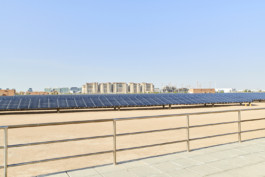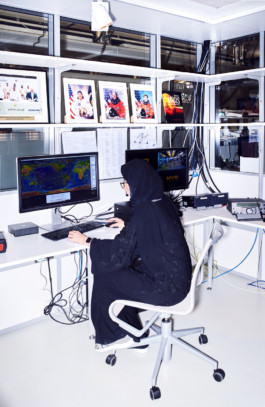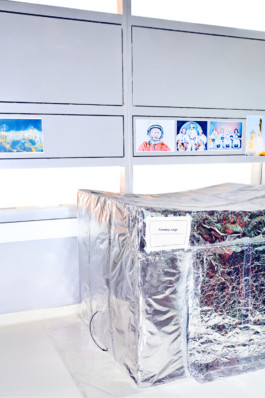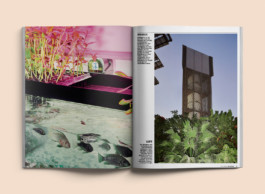Welcome To The Future, 2019
In Masdar City, a climate-neutral desert city in Abu Dhabi, more than 90,000 people are supposed to live and work by 2030. Through special architecture, the choice of building materials, its own scientific research and energy production, the city should conserve resources to meet the demands of the future world which is facing the problems of the global climate change.
In 2019 the city is still far away from this point. About 400 students live in the 13 completed buildings. Another 2000 people commute to work in Masdar City every day. So far, the city area’s dimension is only half a square kilometre.


Four chickens in the "Eco-Villa", which shows visitors the life of the future.
The wind tower in the city core cools down the ambient air and makes it possible to spend time outdoors even at high temperatures.



Reem during a ride in the "Personal Rapid Transfer". Originally, the PRT was planned to transport everyone through Masdar City. Currently, it only operates as a tourist attraction in the underground parking garage.





An exhibition inside the "Eco-Villa" shows another idea for future homes: Aquaponic. The plants use the fish excreta to grow faster and improve the indoor air through photosynthesis.
Prof. Prashant is the leader of the university's space laboratory which developed the satellite in the back.










Abu Dhabi is one of the regions with one of the highest water- and electricity consumptions in the world. Public transport does not play a big role and cars with internal combustion engines are more common than any other vehicle. For a long time, oil and gas seemed to be endless. The wealth of the region is basically built up on the occurence of these resources.
To establish an awareness for a sustainable, eco-friendly, climate neutral lifestyle in the emirate will be a long way to go. But does there exist any alternative for Abu Dhabi?
If Masdar City in the end will be part of a movement in society and politics or will be the monument of an uncompleted vision the time will show.

— The view of the custruction side shows there is a lot of space left for the city of the future.

Welcome to the Future, 2019
The series was published in SPIEGEL climate special issue 2020.
It received the BFF talent grant 2019 and was exhibited in Germany at Umweltfotofestival Horizonte Zingst, Regional Council Karlsruhe as well as at Kunstmuseum Bochum and State Representation of Lower Saxony, Berlin as part of the exhibition »Zuhause« in 2019.





SPIEGEL climate special issue 2020

Welcome To The Future, 2019
In Masdar City, a climate-neutral desert city in Abu Dhabi, more than 90,000 people are supposed to live and work by 2030. Through special architecture, the choice of building materials, its own scientific research and energy production, the city should conserve resources to meet the demands of the future world which is facing the problems of the global climate change.
In 2019 the city is still far away from this point. About 400 students live in the 13 completed buildings. Another 2000 people commute to work in Masdar City every day. So far, the city area’s dimension is only half a square kilometre.

Four chickens in the "Eco-Villa", which shows visitors the life of the future.

The wind tower in the city core cools down the ambient air and makes it possible to spend time outdoors even at high temperatures.


Reem during a ride in the "Personal Rapid Transfer". Originally, the PRT was planned to transport everyone through Masdar City. Currently, it only operates as a tourist attraction in the underground parking garage.





An exhibition inside the "Eco-Villa" shows another idea for future homes: Aquaponic. The plants use the fish excreta to grow faster and improve the indoor air through photosynthesis.

Prof. Prashant is the leader of the university's space laboratory which developed the satellite in the back.









Abu Dhabi is one of the regions with one of the highest water- and electricity consumptions in the world. Public transport does not play a big role and cars with internal combustion engines are more common than any other vehicle. For a long time, oil and gas seemed to be endless. The wealth of the region is basically built up on the occurence of these resources.
To establish an awareness for a sustainable, eco-friendly, climate neutral lifestyle in the emirate will be a long way to go. But does there exist any alternative for Abu Dhabi?
If Masdar City in the end will be part of a movement in society and politics or will be the monument of an uncompleted vision the time will show.

— The view of the custruction side shows there is a lot of space left for the city of the future.

Welcome to the Future, 2019
The series was published in SPIEGEL climate special issue 2020.
It received the BFF talent grant 2019 and was exhibited in Germany at Umweltfotofestival Horizonte Zingst, Regional Council Karlsruhe as well as at Kunstmuseum Bochum and State Representation of Lower Saxony, Berlin as part of the exhibition »Zuhause« in 2019.





SPIEGEL climate special issue 2020
↑
back to top